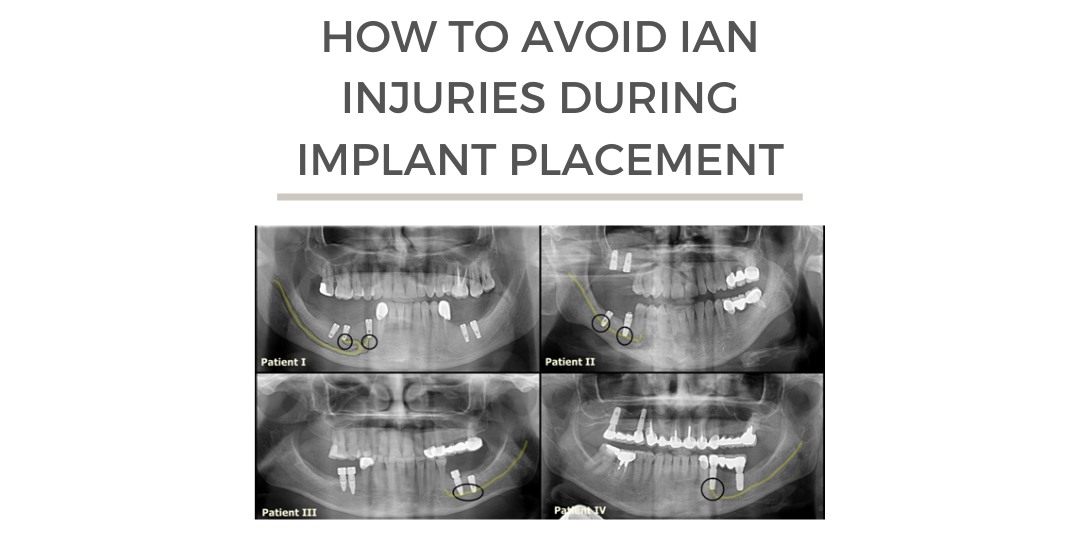| Did you know? During mandibular implant placement the most frequently injured nerve is the IAN at 64.4% follow by the Lingual nerve at 28.8%. Implant placement can effectively improve patient quality of life by restoring aesthetics, form, function. Some cases can be challenging specially in the mandibular region where IAN lies. Here are some tips to help avoid complications of nerve injury when placing mandibular implants: Anatomical The mandibular branch of Trigeminal Nerve (V3) enters the mandibular foramen and becomes the inferior alveolar nerve. Bundled with the inferior alveolar artery, vein, lymph, the IAN runs through the mandibular canal (MC). Important anatomy to consider when assessing for implant osteotomy in the mandible include: • Cadaver studies demonstrate an average distance of 3.5-5.4mm between root apices of 1st molar and MC. • High vertically positioning of MC that is within 2mm from the apices of 1st and 2nd molar is present in some patients. • Atrophy of mandibular ridge in areas of missing teeth allows for higher positioned IANs and Mental nerves. • Bifid or trifid MC is anatomical variations that must be taken into consideration. IAN separates from mandibular nerve (V3) and enters the body of the mandible at the lingula. It then travels within the mandibular canal lingual in the molar region and progresses buccal as it exists the mental foramen and provides innervation to the lower lip skin, mucosa, and gingiva as far posterior as the 2nd premolar. • Mental formen (MF) opening on the body of the mandible is a mean size of 3.5mm. • The location of MF can vary, however, it is commonly found between the apices of the 1st and 2nd premolar or the apex of 2nd premolar. • The MF is less frequently found to be located between the premolar and molar or mesial to the first premolar. • 25-38% of MF are found coronal to the premolar apices • In the area of the MF, the IAN often runs anteriorly up to 5mm and makes an intraosseous loop onto itself prior to exiting the MF. • The anterior loop varies in the direction of its loop, and can sometimes be clinically identified by very gently probing the MF (hence an open mesial portion would indicate an anterior loop). |
 The incisive branch of the mental nerve supplies the mandibular incisors and canines. |
| Radiological The ideal imaging modality for treatment planning of dental implants is a cone beam CT scan (CBCT). Previously used radiographic modalities such as panoramic X-rays and periapical X-rays are no longer adequate for treatment planning due to their limitation in assessing many key anatomic features of the bone, including: presence of mylohyoid ridge in posterior mandible and available bone width in the edentulous space. • Studies concluded that volvex values of CBCT cannot be used to correctly estimate bone density of cancellous bone. • Buccolingual position of MC can influence the vertical position of the MC on a panoramic radiograph. • Mandibular Tori can obscure the amount of bone height available and make it difficult to see the borders of the MC clearly. • CBCT is the best tool for identifying the postion of IAN and MN. |
  |
| • Due to the ability of precisely identifying anatomical landmarks, high accuracy and low radiation exposure, CBCT has been suggested to be the main method for radiographic pre-implant planning tool. • PA radiographs angulations can cause distortion. • Panoramic radiographs suffer from low resolution, higher distortion, potential of overlapping anatomical structures, and their image is often related to the bone density of the patient and sometimes it’s difficult to accurately identify vital structures. |
 |
| Procedural • For a patient with severe atrophy of the alveolar process, initial incision should be made more lingual in premolar region avoiding the MF and the mental nerve. • Implant osteotomy and placement should be at least 2 mm coronal to the most superior portion of the mandibular canal. • IAN injury can happen as a result of direct injury to IAN during nerve block, during preparation of the osteotomy or secondary to hematoma of surrounding vital structure. There have been reported cases of neurotoxicity of anesthetic (Articane) however, it is less common. • In an instance when the MN cannot be identified via CBCT, osteotomies should be placed at least 6mm anterior to the radiographical mental foramen to avoid the anterior loop. |
 Panoramic radiograph showing extension of the mental nerve beyond the mental foramen boundary as an intraosseous anterior loop (arrows). |
Today’s Morning Huddle was brought to you by Dr. Arash Mobini – Toronto, Ontario.


